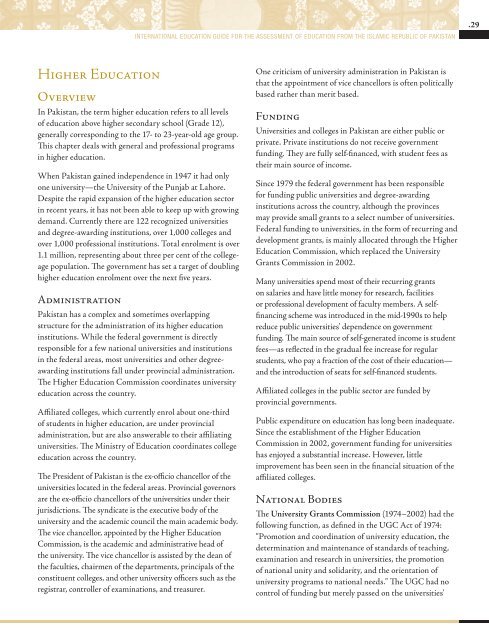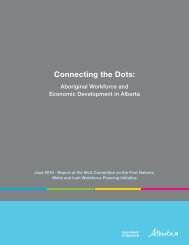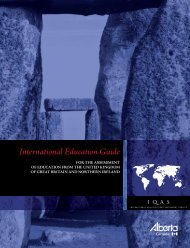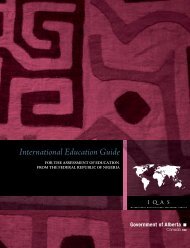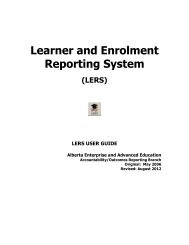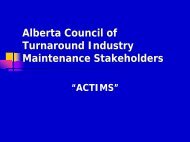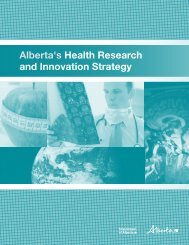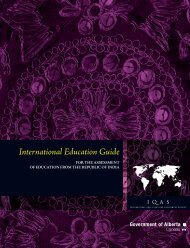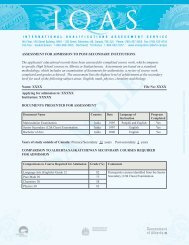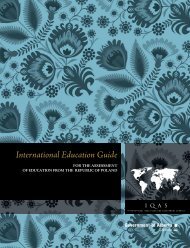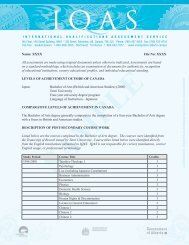International Education Guide - Enterprise and Advanced Education ...
International Education Guide - Enterprise and Advanced Education ...
International Education Guide - Enterprise and Advanced Education ...
Create successful ePaper yourself
Turn your PDF publications into a flip-book with our unique Google optimized e-Paper software.
INTERNATIONAL EDUCATION GUIDE for the assessment of education from the Islamic Republic of Pakistan<br />
.29<br />
Higher <strong>Education</strong><br />
Overview<br />
In Pakistan, the term higher education refers to all levels<br />
of education above higher secondary school (Grade 12),<br />
generally corresponding to the 17- to 23-year-old age group.<br />
This chapter deals with general <strong>and</strong> professional programs<br />
in higher education.<br />
When Pakistan gained independence in 1947 it had only<br />
one university—the University of the Punjab at Lahore.<br />
Despite the rapid expansion of the higher education sector<br />
in recent years, it has not been able to keep up with growing<br />
dem<strong>and</strong>. Currently there are 122 recognized universities<br />
<strong>and</strong> degree-awarding institutions, over 1,000 colleges <strong>and</strong><br />
over 1,000 professional institutions. Total enrolment is over<br />
1.1 million, representing about three per cent of the collegeage<br />
population. The government has set a target of doubling<br />
higher education enrolment over the next five years.<br />
Administration<br />
Pakistan has a complex <strong>and</strong> sometimes overlapping<br />
structure for the administration of its higher education<br />
institutions. While the federal government is directly<br />
responsible for a few national universities <strong>and</strong> institutions<br />
in the federal areas, most universities <strong>and</strong> other degreeawarding<br />
institutions fall under provincial administration.<br />
The Higher <strong>Education</strong> Commission coordinates university<br />
education across the country.<br />
Affiliated colleges, which currently enrol about one-third<br />
of students in higher education, are under provincial<br />
administration, but are also answerable to their affiliating<br />
universities. The Ministry of <strong>Education</strong> coordinates college<br />
education across the country.<br />
The President of Pakistan is the ex-officio chancellor of the<br />
universities located in the federal areas. Provincial governors<br />
are the ex-officio chancellors of the universities under their<br />
jurisdictions. The syndicate is the executive body of the<br />
university <strong>and</strong> the academic council the main academic body.<br />
The vice chancellor, appointed by the Higher <strong>Education</strong><br />
Commission, is the academic <strong>and</strong> administrative head of<br />
the university. The vice chancellor is assisted by the dean of<br />
the faculties, chairmen of the departments, principals of the<br />
constituent colleges, <strong>and</strong> other university officers such as the<br />
registrar, controller of examinations, <strong>and</strong> treasurer.<br />
One criticism of university administration in Pakistan is<br />
that the appointment of vice chancellors is often politically<br />
based rather than merit based.<br />
Funding<br />
Universities <strong>and</strong> colleges in Pakistan are either public or<br />
private. Private institutions do not receive government<br />
funding. They are fully self-financed, with student fees as<br />
their main source of income.<br />
Since 1979 the federal government has been responsible<br />
for funding public universities <strong>and</strong> degree-awarding<br />
institutions across the country, although the provinces<br />
may provide small grants to a select number of universities.<br />
Federal funding to universities, in the form of recurring <strong>and</strong><br />
development grants, is mainly allocated through the Higher<br />
<strong>Education</strong> Commission, which replaced the University<br />
Grants Commission in 2002.<br />
Many universities spend most of their recurring grants<br />
on salaries <strong>and</strong> have little money for research, facilities<br />
or professional development of faculty members. A selffinancing<br />
scheme was introduced in the mid-1990s to help<br />
reduce public universities’ dependence on government<br />
funding. The main source of self-generated income is student<br />
fees—as reflected in the gradual fee increase for regular<br />
students, who pay a fraction of the cost of their education—<br />
<strong>and</strong> the introduction of seats for self-financed students.<br />
Affiliated colleges in the public sector are funded by<br />
provincial governments.<br />
Public expenditure on education has long been inadequate.<br />
Since the establishment of the Higher <strong>Education</strong><br />
Commission in 2002, government funding for universities<br />
has enjoyed a substantial increase. However, little<br />
improvement has been seen in the financial situation of the<br />
affiliated colleges.<br />
National Bodies<br />
The University Grants Commission (1974–2002) had the<br />
following function, as defined in the UGC Act of 1974:<br />
“Promotion <strong>and</strong> coordination of university education, the<br />
determination <strong>and</strong> maintenance of st<strong>and</strong>ards of teaching,<br />
examination <strong>and</strong> research in universities, the promotion<br />
of national unity <strong>and</strong> solidarity, <strong>and</strong> the orientation of<br />
university programs to national needs.” The UGC had no<br />
control of funding but merely passed on the universities’


